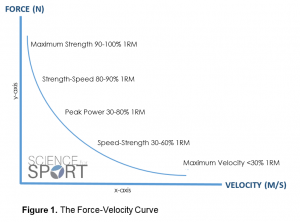
I have talked about the importance of the force-velocity before on here. However, for this post, I would like to provide some practical examples. I have also talked recently about applying the correct workout stimuli, particularly in this period of isolation. As a result, I want to provide practical examples for each section on the force-velocity curve and how you might implement them into a session. So without further ado, let’s jump straight in a t the top of the curve.
Max Strength
These lifts are going to be about producing the most force possible, irrelevant of how quickly you do it. We are talking absolute strength here. Your muscles ability to produce the most amount of force possible. As you can imagine, programming exercises for this portion of the curve are pretty simple. Keep them simple, keep them heavy! We are talking bilateral, multi-joint movements.
Squat, Deadlift, Bench etc – all above 85% of 1RM.
Strength Speed
Here you want to start moving a little bit fast. You’re not exploding, but, you don’t want want to be spending a good few seconds grinding out each and every rep. Olympic Lifts such as the Clean, Snatch and Jerk are often used in this portion. However, technique can often be a limiting factor. Because of this, I like to use derivatives and variations of the full movements
In addition to the exercises used for max strength, Clean and Snatch pulls and Power jerks can be loaded heavily but still move with some speed. Use 80-90% 1RM as a guide.
Power
You should now have a decent idea of how these sections start to move. We now want to be moving faster but still maintaining a decent amount of load on the bar. Unfortunately, research on “power” has provided somewhat wide bandwidths for what is effective. This does mean you can have a lot of play time in this portion and shift the focus towards strength or speed however you wish!
Loaded jumps, Hang and power olympic lift variations and throws are all great exercises to use here. anywhere between 30-80% of 1RM can elicit adaptions in “power” properties.
Speed Strength
Basically, the opposite to strength speed! You now want the speed of movement to be the over ruling factor in these movements. Looking back at the plyometric blog I posted recently, your slower, ballistic early variations are what you can start to include here. You can still load them up, however the focus is on speed.
Countermovement Jumps, Power variations of olympic lifts, reactive throws and Box Jumps can all be utilised here. 30-60% 1RM for your traditional lifts.
Max Speed
Pretty self explanatory. Move fast. Rebounding activities, multiple jumping, sprinting and throwing. Anything that falls into those categories can be utilised. If you are going to load up any movements, keep them below 30% of 1RM.
Understanding The Force-Velocity Curve is Key
As a Leading Strength and Conditioning Coach in Berkshire, it is important that both my clients and I understand what we are trying to achieve. By understanding the force-velocity curve, we can get the most out of every session and every exercise.
